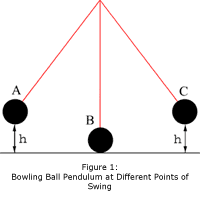
First we begin with a bowling ball on a cable that is attached to a stand. The bowling ball is held up in the air (and in front of someone's nose) so that the cable is taut. This is shown as A in Figure 1. At this position, the bowling ball is not moving, so it does not have any Kinetic Energy to start with. It does have some Gravitational Potential Energy, however, because we have lifted it off the ground. This is the only energy the ball has to begin with.
When the ball is released (without being pushed), the ball begins to move. This is when some of the potential energy is turned into kinetic energy. When the ball reaches the bottom of its swing, all its initial potential energy has changed into Kinetic energy. This is represented as B in Figure 1. But no energy was lost-- it was all changed into a different type of energy.
Since it has all that Kinetic energy, it swings back up until all the Kinetic energy is converted back to potential on the other side, when it reaches the top of its swing. It is important to note that since the Total amount never changes, that the Potential it has now is the same it started out with when it was in front of the person's nose (*) This is represented as C in Figure 1.
The potential energy cannot be greater when the ball returns close to the person's face than it had when it started there. To hit the person in the face, it would need more energy to pass the height it started from. This is not possible because of the law of Conservation of Energy. Energy can change forms, but the total amount NEVER changes.
(*) The potential energy at this position will actually be slightly less than the original potential energy due to some energy being converted into another type of energy by heat. Energy is still conserved. This will be discussed in the next demo, when we talk about Friction.
